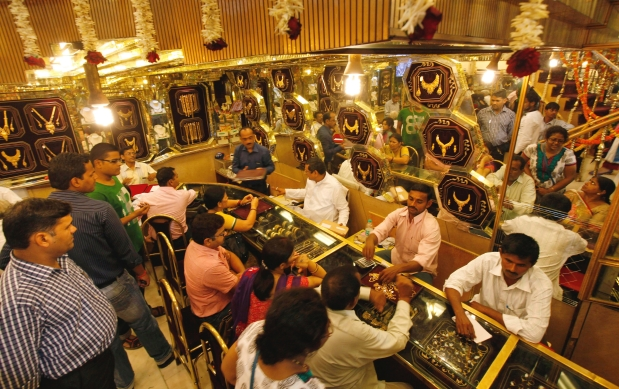
Indians love gold. High global prices, steep import duties and yet we keep purchasing the yellow metal as if it was going out of fashion.
In 2011, India imported more gold than any other country—about 1,000 tonnes, or a fifth of the annual global supply. That is the same amount that sits in the central bank vaults of Switzerland. According to Reuters, Indian gold imports in the fiscal year 2014-15 ended March 31 jumped to 900 tonnes, up 36 percent from a year ago.
Unfortunately, this gold sits idle in our lockers and bank vaults, earning no interest and not helping the country improve its economy or infrastructure.
Give Bullion, Get Money
In a welcome move now, the government has come out with a gold monetisation scheme. In principle, the scheme will offer two benefits.
First, it will allow individuals and institutions to earn interest by depositing their gold stockpile with banks. In addition, the gold that is mopped up can be sold to jewellers, thus meeting the insatiable domestic demand for gold on one hand and bringing down the budget deficit on the other. Gold imports constitute one of the largest chunks of non-oil imports and every year the government has to spend valuable foreign exchange footing this bill. If we stop (or even reduce) gold imports it will correct our balance of payments situation immediately and the deficit.
How the scheme works is simple. Gold - even as little as 30gm is fine – first needs to be evaluated by hallmarking centres, spread across the country. Currently there are 24 Bureau of Indian Standards (BiS) recognised hallmarking centres which will be expanded significantly across 602 districts.
The gold can be in any form: jewellery, bars, coins, whatever. The hallmarking centre will conduct an x-ray fluorescence test to assess the level of purity of the gold. Once that is done, the gold will be melted down, through a fire assay process which removes impurities. The chunk of (purified and melted) gold is then handed back, along with a hallmarked certificate endorsing the quantity (weight) and quality (carats) of the gold.
With this certificate, a gold savings account can be opened at any designated bank.
Interest (the exact rate is yet to be finalised) to be received at the time of redemption of the scheme can be in the form of gold or cash. Functioning like any fixed deposit, both the principal and the interest will be returned on maturity. Proceeds can be received in either gold or cash. An additional benefit, one presumes will be any appreciation in the market price of gold which will accrue to the depositor after a year, on maturity.
Windfall For Temples?
Press reports say that the scheme has the potential to free up a staggering Rs. 60 lakh crore of gold from households, trusts and institutions, given the assumption that over 20,000 tonnes of gold lies idle.
To sweeten the deal further the government has said that the interest depositors earn from these gold deposits will be free of income tax and capital gains tax.
And it is not just individuals and families who will benefit. Social organisations, temples and religious trusts that are custodians of massive amounts of gold donated by devotees will be major beneficiaries. According to the World Gold Council, over 22,000 tonnes of gold lies locked away in various temples in India.
The ET reports in an editorial titled ‘Give Unto Caesar Gold that is God’s’ that last August, about 1,800 kg of gold was reportedly deposited with the SBI, taking the total deposits of the Tirupati Trust to over 5,000 kg.”
Recently the Sri Padmanabhaswamy temple in Kerala, hit the headlines when a treasure chest valued at a staggering $22 billion (Rs. 90,000 crore) of gold, jewels and statues was discovered in the 16th century temple.
But The Lure For Gold Will Linger
So on the face of it is a win-win scheme. Depositors get interest putting their idle gold to work, banks an additional source of income and fresh liquidity, jewellers ready raw material and more business for gold refining and hallmarking firms. The government is able to bring down its import bill and hopefully deploy this savings towards infrastructure and other nation-building activities.
However, how successful the gold monetisation scheme will be will depend on a few key factors.
First, the interest rate being offered. In the schemes offered in the past, rates have been 50 basis points to 2% at best. This is way low. Unless it is somewhere around 4%, the scheme will not find too many takers. It is also not clear if the interest rate will be fixed or banks will have the flexibility to offer variable rates to customers.
Trust Deficit is another issue. While income and capital gains tax may have been waived off, there is no clarity on whether questions will be asked about the source or origin of the gold. Most families will be very reluctant to lug gold that may have been acquired from multiple sources and assorted situations over the years to the nearest hallmarking centre, fearing harassment by tax authorities.
A lot of the personal gold in our country is in the form of jewellery. There is a lot of sentimental and historical value attached to gold jewellery and artifacts. It is passed down generations as heirlooms and pride is taken in the quality of craftsmanship. It is also considered auspicious which is why we buy so much on days like Akshaya Tritiya and Diwali.
Gold, especially gold jewellery along with being savings for a rainy day, occupies a unique psychological place in most Indian hearts.
Melting it down into impersonal biscuits or bars, for a frugal 1% - 2% return is something that is unlikely to find too many takers. Offering an attractive interest rate is a must.